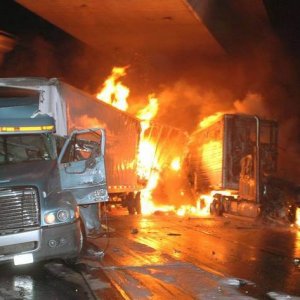
University at Buffalo engineers, and CAIT UTC partners, Dr. Negar Elhami-Khorasani and Dr. Anthony Tessari are looking at how to improve fire safety in tunnels.
Most people view tunnels as a matter of convenience, a way to get from Point A to Point B with minimum complications — depending on weather and traffic patterns, of course.
Dr. Negar Elhami-Khorasani and Dr. Anthony Tessari look at tunnels differently than most people. The two University at Buffalo (UB) researchers are more concerned with the efficacy of transportation via tunnels that many don’t often consider: fire safety.
“Concrete structures typically behave well at high temperatures and do not collapse when subjected to moderate fires,” says Elhami-Khorasani, who, like Tessari, is an associate professor in the School of Engineering and Applied Sciences’ Department of Civil, Structural and Environmental Engineering. “Yet, these structures experience damage and require repair after the fire to resume function.”
“(Our) project goal is to increase safety and minimize economic losses in the transportation network by enhancing the resilience of existing and new tunnels subject to fire events. In particular, this project studies fire damage in concrete tunnel structures through combined numerical and experimental studies and integrated knowledge from structural fire engineering and geotechnical engineering.”
Elhami-Khorasani, Tessari, and then-doctoral student Nan Hua (who received a PhD last year) investigated the performance measures and thresholds for fire damage of the reinforced concrete liners in the tunnel structure.
The research combined knowledge from fire, structural and geotechnical engineering.

Photo ©AP/Mike Meadows.
“Previous historical events confirm that tunnel fires may not necessarily cause collapse, but significant damage to the tunnel lining and long-term disruption to traffic/rail services can lead to major economic losses,” Elhami-Khorasani warns. “Meanwhile, the available guidelines on damage assessment of concrete structures after a fire are limited, and the evaluation is performed mostly on an ad hoc basis.”
The research, supported by the Region 2 University Transportation Center (UTC) Consortium led by the Center for Advanced Infrastructure and Transportation (CAIT) at Rutgers University and the UB Institute of Bridge Engineering, addresses U.S. Department of Transportation priorities “on ‘improving durability and extending the life of infrastructure’ and ‘system response to disruptive events/resilience to disasters,’” she says.
According to Elhami-Khorasani, the team’s research determined a “method to measure damage, in terms of volume of the concrete that needed repair, across the tunnel length.” Fire tests of concrete slabs were conducted in a furnace at UB’s Structural Engineering and Earthquake Simulation Laboratory (SEESL). The slabs were heated to 1,500 degrees F (850 degrees Celsius).
Thanks to the fire tests, researchers found that “systematic performance measures and damage thresholds for post-fire assessment of reinforced concrete tunnel liners can be proposed to guide repair actions and ensure safety, minimize downtime and reduce economic losses incurred due to the downtime of such critical infrastructure,” Elhami-Khorasani said.
“… The information from visual inspections (of tunnels) and (non-destructive testing) techniques can be supplemented with results of advanced modeling and analysis of the structure subjected to fire to guide the damage assessment procedure. Prediction of damage through modeling can be used during the design phase to assess the risk and develop design solutions that are safe and economical.”
This article originally appeared on UBNow. Click here to read it in full.

